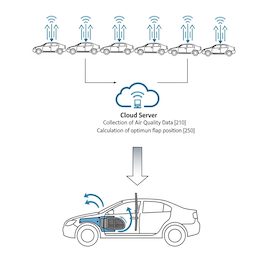Adaptive Cabin Air Quality Control System Using Real-Time Air Quality Map With And Without On-Board Air Quality Sensor (AQS)
Patent Status
| Country | Type | Number | Dated | Case |
| United States Of America | Published Application | 20240246391 | 07/25/2024 | 2022-896 |
Full Description
Background
The standard "automatic" mode for vehicle ventilation systems offers a suboptimal experience. Current vehicle cabin air systems are reactive, only closing the air intake vents after an onboard sensor detects poor air quality, which is often too late. This approach fails to protect occupants from breathing in pollutants in the first few moments of entering a high pollution zone, and it cannot anticipate upcoming areas of poor air quality.
Technology
Prof. Heejung Jung and his team have developed a novel, cloud-based platform that provides adaptive cabin air quality control for any connected vehicle. The system collects real-time data from a network of mobile sensors to generate dynamic air quality maps. For a specific vehicle, the system calculates the optimal position for the air intake flap based on its precise location and the pollution levels predicted along its path. A recommendation is then sent to the vehicle, allowing it to intelligently and continuously adjust its air intake, a feature that works even for cars without a dedicated onboard air quality sensor.

Conceptual illustration of the invention - Data from a network of vehicles is collected by a central cloud server. The server processes this information to create real-time air quality maps and calculates the optimal air flap position for a specific vehicle. This command is then sent to the car enabling it to proactively adjust its systems for ideal in-cabin air quality.
Advantages
- Anticipates and protects against poor air quality zones before the vehicle enters them.
- Offers naunced adjustment of the air intake flap (e.g., partially open) rather than a simple on/off reactive approach.
- Leverages data from a fleet of vehicles to create highly accurate, real-time pollution map that benefits all users.
- Intelligently balances the trade-off between blocking external pollutants and reducing in-cabin CO2 concentration.
Suggested uses
- Integration into passenger and commercial vehicles.
- Protecting the health of commercial drivers in delivery vans and long-haul trucks.
Contact
- Venkata S. Krishnamurty
- venkata.krishnamurty@ucr.edu
- tel: View Phone Number.
Other Information
Keywords
adaptive air control sysetm, air pollution, automotive HVAC, cabin air quality, connected vehicle, in-cabin health, predictive control, real-time data mapping, smart climate control, vehicle sensor network
